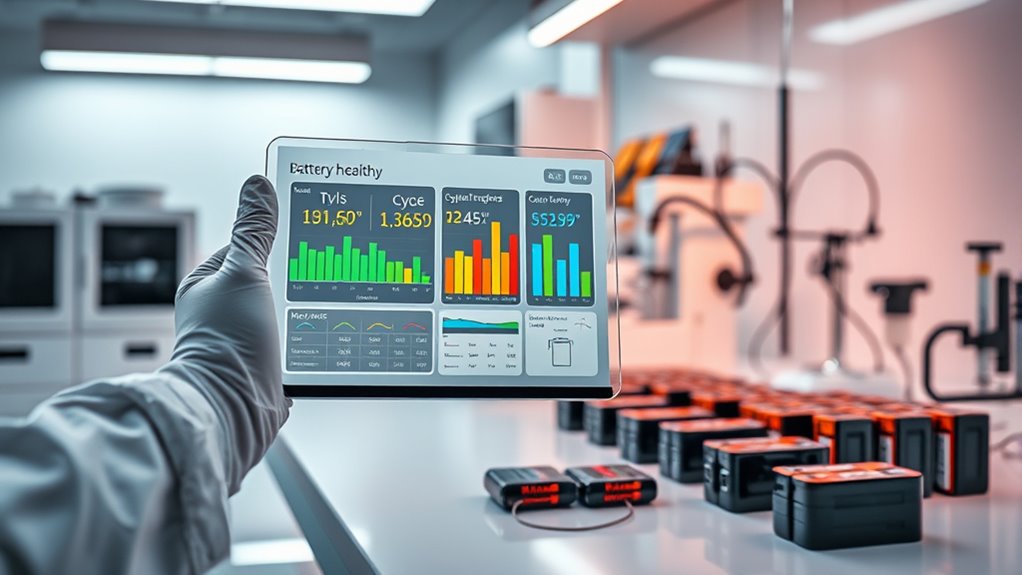To monitor a battery’s state of health for reuse decisions, you gather lifecycle data like voltage, current, temperature, and charge cycles continuously. Analyzing this data helps identify gradual capacity loss, abnormal patterns, and potential faults early. This proactive approach allows you to accurately assess remaining life and determine if the battery is suitable for reuse or needs replacement. Exploring how advanced predictive models enhance this process will show you even more effective strategies.
Key Takeaways
- Continuous data collection of voltage, current, temperature, and charge cycles enables accurate assessment of battery health.
- Data analysis techniques identify subtle signs of aging and capacity degradation over the battery’s lifespan.
- Predictive models estimate remaining capacity and forecast future performance to inform reuse decisions.
- Early detection of abnormalities helps prevent failures and extends battery usability for second-life applications.
- Monitoring state of health supports data-driven decisions for safe, efficient battery reuse and lifecycle management.

Have you ever wondered how long your battery will last before it needs replacing? Understanding this isn’t just about guessing when your device might die; it’s about gaining insight into the battery’s health through careful monitoring. Battery degradation is a gradual process, where over time, your battery’s capacity diminishes, and its ability to hold a charge weakens. This decline isn’t always obvious at first glance, but with proper data analysis, you can track these subtle changes and predict when a battery is approaching the end of its useful life. By continuously collecting data on voltage, current, temperature, and charge cycles, you create a detailed picture of how your battery performs under different conditions. This data enables you to identify patterns that signal aging, so you’re not caught off guard when performance drops unexpectedly.
Using data analysis, you can develop models that forecast future battery behavior based on current trends. These models analyze historical data to determine the rate of degradation, helping you estimate remaining capacity and predict when the battery will no longer be efficient or safe to use. For example, if your data shows a steady decline in capacity over a specific number of charge cycles, you can plan for replacement before the battery fails completely. This proactive approach saves you from inconvenience and prevents potential damage to your device or system caused by overused batteries. Additionally, data analysis allows for early detection of abnormal degradation patterns. If a battery suddenly loses capacity faster than usual, it might signal underlying issues such as manufacturing defects, thermal stress, or improper charging habits. Recognizing these early warnings helps you make informed decisions, whether to replace, repair, or optimize usage to extend the battery’s lifespan.
In essence, tracking battery health through data analysis transforms what might seem like guesswork into precise, actionable insights. Instead of waiting until your device’s performance noticeably declines, you can monitor the subtle signs of aging and make timely decisions about reuse or replacement. This process is especially important for large-scale applications, such as electric vehicles or energy storage systems, where knowing the state of health impacts safety, efficiency, and economic value. As technology advances, integrating real-time monitoring and sophisticated analytics will only improve your ability to manage batteries effectively. Whether for personal gadgets or industrial equipment, understanding battery degradation through detailed data analysis empowers you to maximize the lifecycle of your batteries and make smarter, more sustainable choices.
Frequently Asked Questions
How Accurate Are Current State of Health Estimation Methods?
Current state of health estimation methods are quite accurate, especially when you leverage machine learning algorithms that analyze complex data patterns. Sensor calibration improves precision by ensuring data quality, which directly impacts estimation reliability. You can enhance these methods further by regularly updating models with new data, allowing for more precise predictions. While no system is perfect, combining machine learning with proper sensor calibration markedly boosts the accuracy of battery health assessments.
What Are the Main Challenges in Real-Time Battery Monitoring?
While tackling real-time battery monitoring, you face subtle hurdles like accurately tracking battery aging and ensuring data privacy. You need to manage fluctuating data quality and sensor reliability, which can complicate insights. Balancing the need for continuous monitoring with safeguarding user data is delicate. Overcoming these challenges means developing robust algorithms and secure systems, so you can make confident reuse decisions without compromising privacy or performance.
How Does Temperature Affect Battery Lifecycle Data?
Temperature critically impacts your battery’s lifecycle data through thermal effects. When temperatures exceed certain thresholds, it accelerates degradation, reducing overall health and lifespan. Conversely, very low temperatures can impair performance temporarily. Maintaining ideal thermal conditions helps guarantee accurate health readings and prolongs reuse. By monitoring temperature data closely, you can prevent thermal effects from causing misleading results, ultimately supporting better reuse decisions and extending your battery’s useful life.
Can Existing Data Predict Long-Term Battery Degradation?
Imagine knowing your battery’s future before it fails—that’s what existing data can do. While battery aging introduces uncertainties, your data’s reliability improves with continuous monitoring, helping predict long-term degradation. You can identify subtle signs of decline early, making smarter reuse decisions. Though not perfect, this data offers valuable insights, giving you confidence in managing battery health and extending its lifespan effectively.
What Standards Exist for Battery Lifecycle Data Sharing?
You should know that standards like ISO 15118 and IEEE 2846 promote data interoperability for battery lifecycle data sharing. However, privacy regulations such as GDPR influence how data is exchanged, ensuring sensitive information stays protected. These standards aim to facilitate seamless data sharing across systems while respecting privacy laws, helping you make informed reuse decisions without compromising security or compliance.
Conclusion
So, next time your battery throws a tantrum, remember it’s just telling you its life story. Monitoring its health isn’t just tech talk—it’s your crystal ball for reuse or recycling. Skip the drama, and keep tabs on that battery’s “mood.” After all, who knew that understanding its lifecycle could save you money, the planet, and maybe even your patience? Stay vigilant, or face the shocking surprise of a dead battery when you least expect it!









